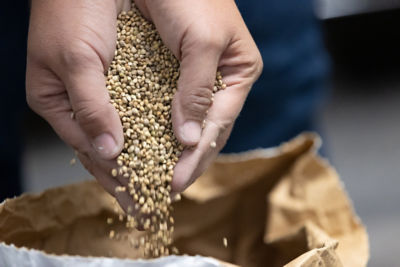Causal Agent
Dickeya chrysanthem i (syn. Erwinia chrysanthemi),
Pectobacterium carotovorum subsp. carotovorum (syn. E. carotovora subsp. carotovora)
Distribution
Mexico and USA (D. chrysanthemi), Worldwide (P. carotovorum subsp. carotovorum)
Symptoms
Bacterial soft rot is mainly a problem on mature bulbs. Affected scales first appear water-soaked and pale yellow to light brown when infected by Dickeya chrysanthemi or bleached gray to white when infected with Pectobacterium carotovorum subsp. carotovorum. As the soft rot progresses, invaded fleshy scales become soft and sticky with the interior of the bulb breaking-down. A watery, foul-smelling thick liquid can be squeezed from the neck of diseased bulbs.
 Soft rot developing late in the season in two bulbs.
Soft rot developing late in the season in two bulbs.
 Early season soft rotting of a bulb.
Early season soft rotting of a bulb.
Conditions for Development
Bacterial soft rot is most common on onions in storage or transit; however, this disease can develop on onions in the field before harvest, after heavy rains and when leaves are drying. The main sources of inoculum are contaminated soil and crop residues. The bacteria is spread by splashing rain, irrigation water and insects. Entry into bulbs is only through wounds such as those caused by transplanting, mechanical injuries or sunscald. Also, onion maggots can carry soft rot bacteria and introduce them while feeding. This disease is favored by warm, humid conditions with an optimum temperature range of 20-30°C (68-86°F). However, during storage or transit soft rot can develop when temperatures are above 3°C (37°F).
Control
Avoid overhead irrigation where possible, and control insect pests such as the onion maggot. Disease spread and infection may be reduced by copper-based bactericides. Allow onion tops to mature before harvesting and avoid damaging bulbs during harvest. Store onion bulbs only after they have been properly dried, and provide the appropriate temperature and humidity with good ventilation to prevent moisture condensation from forming on the bulbs.



